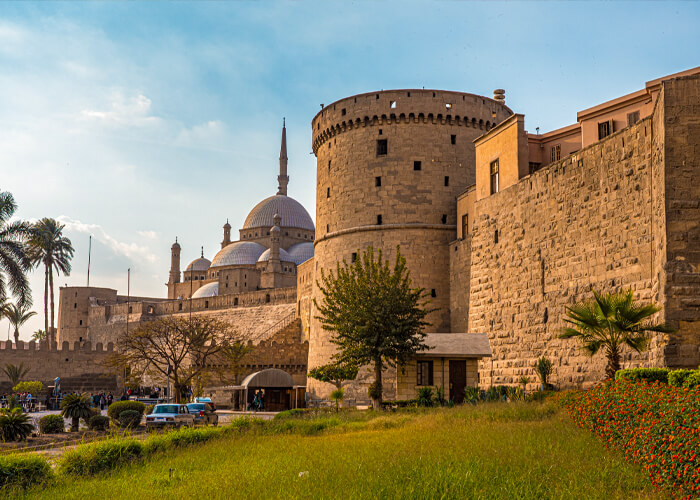Mohammad Aly Mosque & Saladin Citadel – Directions What was Saladin’s name?
The history of Cairo’s Saladin Citadel
There is a citadel within
So who was Mohamed Aly?
Its Mosque’s History
In Cairo, the ancient Citadel of Saladin with the Muhammad Ali Mosque’s enormous towering minarets perches high on a steep hill overlooking Old Islamic Cairo and beyond.
As originally termed Qalaat Sali ad-Din, this colossal structure is home to a collection of museums depicting the history of Egyptian power during the course of the Middle Ages and the early 19th century.
Directions
The Citadel of Saladin is situated in the Mokattam Hills, Cairo’s highest point, about 15 to 25 minutes from the city center.
Which of the following is true about Saladin:
The Salah El-Din Citadel in Cairo was built by El-Nasir Salah El-Din Yusuf Ibn Ayyub, a brave knight who is known in history as Salah El-Din. It is one of Egypt’s most notable historical structures.
Originally from Iraq, he became the first sultan of Egypt and Syria, as well as the founder of the dynasty known as the Ayyubids.
Even though he began military training at the age of 14 and eventually led the Muslim military campaign against the Crusader states, winning the biggest victory of his life by defeating them and capturing Jerusalem, making it an Islamic state, he was a very charitable and religious leader who once said: “I warn you against shedding blood, in the name of Allah.” He was also a powerful military leader who had conquered many states.
Salah Din combines the Arabic words for “justice” and “faith.” History suggests that he died in Syria, aged 56, and was buried at the Umayyad Mosque in Damascus City, Syria, where he had spent much of his life.
The history of Cairo’s Saladin Citadel
to protect Cairo against future Crusader invasions Sultan Salah El-Din built the castle of Salah-Din, also known as the Citadel of the Mountain (Qala’a Al-Jabal) in Egypt
Due to its elevated location on Cairo’s hills, it was very hard to attack and served as a fortress against any kind of violence. Ayyubids, Mamluks, and even certain Ottoman dynasties ruled Egypt from the Citadel for a lengthy period of time in Egypt’s history, making this citadel one of the most important places in the country’s history.
Before Khedive Ismail became Egypt’s king, he moved the Egyptian government’s administrative center from the Citadel to Abdeen Palace for a short time.
The building of the Salah El-Din Citadel started in 1176 on the orders of Sultan Salah El-Din.
Nevertheless, Salah El-Din did not reside in it since the Citadel was finished in 1182, during the time of Al Malek El Kamel, Egypt’s monarch after Salah El-Din died. Salah El-plan Din’s to defend himself from his adversaries included the construction of an outstanding and large castle and fortification.
Small Giza pyramids were used for building blocks, and he was inspired by the fortified Syrian citadels as a consequence of this, making the architecture both magnificent and graceful at the same time.
Within the Citadel, Salah El-Din also constructed water wells for his troops. The El-Mokatam tower, the al-Karkialan tower, and the al-Turfa tower are a few of the citadel’s around 13 towers and four gates (the New Gate, the Middle Gate, and the Citadel Gate).
The citadel also has roughly four palaces (Palace Ablaq, Al-Gawhara Palace, and the National Military Museum, where visitors may see historical cannons, tanks, and equipment that have been utilized in several actual battles throughout history).
Within the Citadel’s defenses
Located in the Salah El-Din Citadel, the Alabaster Mosque, or Mosque of Muhammad Ali, is one of the world’s best-known medieval mosques.
The Salah El-Din Citadel contains it.
The mosque was ordered to be built in 1816 by Ottoman caliph Muhammad Ali Pasha, and it took roughly 18 years to fulfill his commands.
In honor of his deceased son Tosun Pasha, Muhammad Ali Pasha built this mosque.
So, who was Mohamed Aly, and what was his significance?
The history books and historians have supplied us with a tremendous quantity of knowledge on Muhammad Ali, even though he was born in Greece.
His 43-year reign began in 1805, when he landed in Egypt to recapture it from Napoleonic domination. After the British forced him to accept the throne, Muhammad Ali became Egypt’s ruler and was given the highest formal title of Pasha.
His rule over Egypt was marked by a series of reforms and improvements in a range of disciplines, including education, industry, and agriculture. He was given the highest official accolade in the Ottoman Empire.
At his death, Muhammad Ali Pasha left behind a rich legacy and was buried at Salah El-Din Citadel, inside his mosque, which bears his name, on the second of August, 1849.
Its Mosque’s History
The Muhammad Ali mosque, which was finished in 1848 and dedicated to the remembrance of Muhammad Ali, was built in an Ottoman architectural style and positioned on the highest point of Salah El-Din Citadel.
On the interior, the mosque is split into two sections:
eastern part, known as the house of prayer, and western section, known as the courtyard, are the two sections.
Incorporating elements from traditional Turkish architecture, this mosque was designed by Turkish architect Yusuf Boshnak and constructed mostly from limestone as the principal building material.
The mosque’s dome is adorned with a medallion honoring each of the four Caliphs who guided the Muslim faith in the right direction..
On the mosque’s two minbars are the names of Allah (God) and Mohamed (the Prophet), as well as Abou Bakr, Omar, Othman, and Ali. The mosque’s dome is embellished with six medallions.

